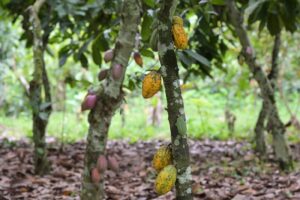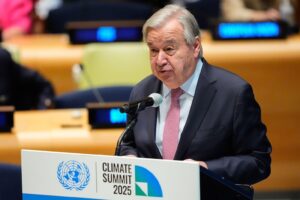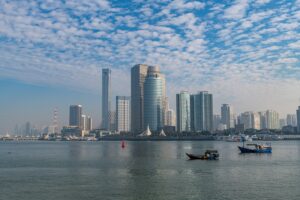Feeding the 8.2 billion people who inhabit the planet depends on healthy soils.
Yet, soil health has been declining over the years, with more than one-third of the world’s agricultural land now described by scientists as “degraded”.
Furthermore, the world’s soils have lost 133bn tonnes of carbon since the advent of agriculture around 12,000 years ago, with crop production and cattle grazing responsible in equal part.
As a result, since the early 1980s, some farmers have been implementing a range of practices aimed at improving soil fertility, soil structure and soil health to address this degradation.
Soil health is increasingly on the international agenda, with commitments made by various countries within the Global Biodiversity Framework, plus a declaration at COP28.
Yet, there is still a lack of knowledge about the state of soils, especially in developing countries.
Below, Carbon Brief explains the state of soil health across the world’s farmlands, the factors that lead to soil degradation and the potential solutions to regenerate agricultural soils.
- What is soil health?
- Why are agricultural soils being degraded?
- Why is soil health important for food security and climate mitigation?
- How can CO2 removal techniques improve soil carbon?
- How can agricultural soil be regenerated?
- What international policies promote soil health?
What is soil health?
Agricultural soil is composed of four layers, known as soil horizons. These layers contain varying quantities of minerals, organic matter, living organisms, air and water.
The upper layers of soil are rich in organic matter and soil organisms. This is where crops and plants thrive and where their roots can be found.
Below the topsoil is the subsoil, which is more stable and accumulates minerals such as clay due to the action of rain, which washes down these materials from the topsoil to deeper layers of the soil.
The subsoil often contains the roots of larger trees. The deeper layers include the substrate and bedrock, which consist of sediments and rocks and contain no organic matter or biological activity.
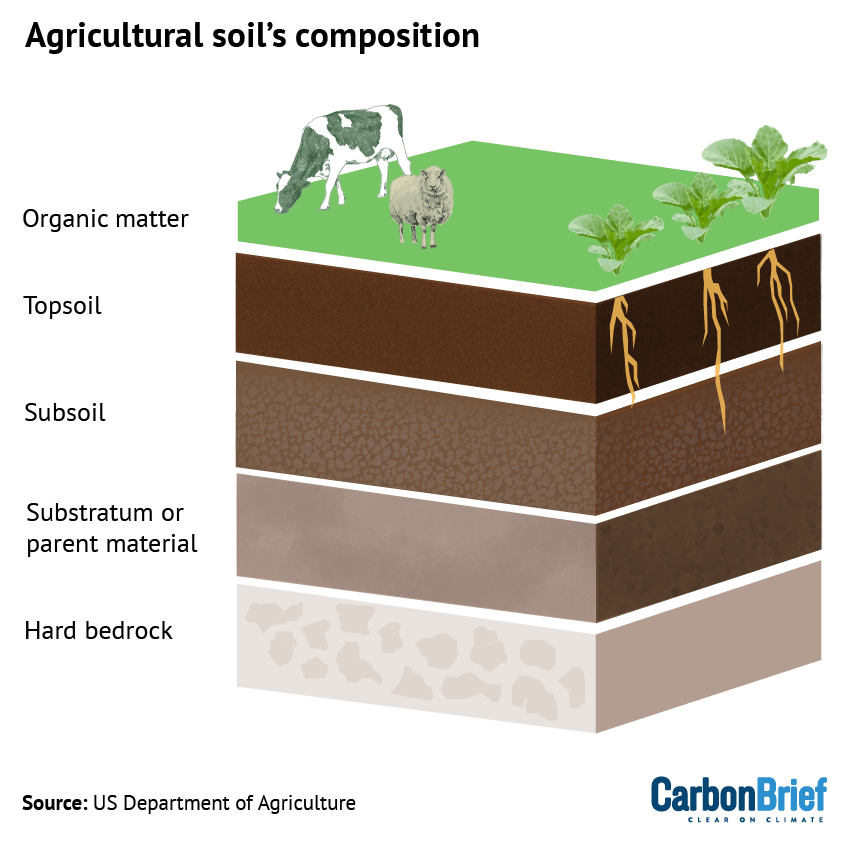
Soil organic matter consists of the remains of plants, animals and microbes. It supports the soil’s ability to capture water and prompts the growth of soil microorganisms, such as bacteria and fungi, says Dr Helena Cotler Ávalos, an agronomic engineer at the Geospatial Information Science Research Center in Mexico.
Some of these organisms can help roots find nutrients, even over long distances, while others transform nutrients into forms that plants can use. Cotler Ávalos tells Carbon Brief:
“Life in the soil always starts by introducing organic matter.”
Soil is typically classified into three types – clay, silt and sand – based on the size and density of the soil’s constituent parts, as well as the mineral composition of the soil. Porous, loamy soils – a combination of clay, silt and sand – are considered the most fertile type of soil. The mineral composition also influences the properties of the soil, such as colour.
Healthy soils contain three macronutrients – nitrogen, phosphorus and potassium – alongside a range of micronutrients. They also contain phytochemicals, which have antioxidant and anti-inflammatory properties and are important for human health.
Below is a graphic showing the elements that constitute healthy soils, including non-mineral elements such as hydrogen, carbon and oxygen (shown in green), according to the Nature Education Knowledge Project.
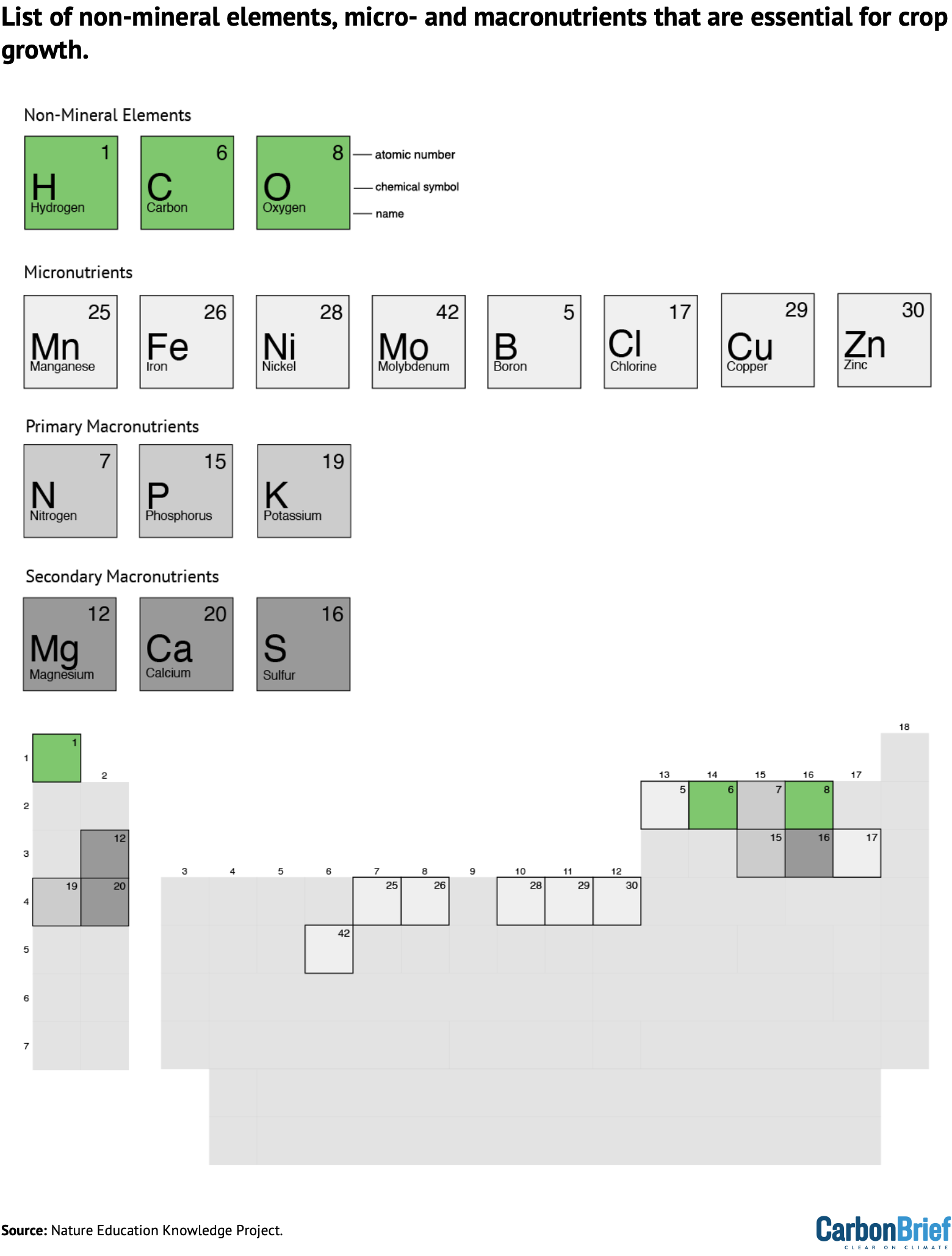
The concept of “soil health” recognises the role of soil not only in the production of biomass or food, but also in global ecosystems and human health. The Intergovernmental Technical Panel on Soils – a group of experts that provides scientific and technical advice on soil issues to the Global Soil Partnership at the UN Food and Agriculture Organization (FAO) – defines it as the “ability of the soil to sustain the productivity, diversity and environmental services of terrestrial ecosystems”.
Soils can sequester carbon when plants convert CO2 into organic compounds through photosynthesis, or when organic matter, such as dead plants or microorganisms, accumulate in the soil. Soils also provide other ecosystem services, such as improving air and water quality and contributing to biodiversity conservation.
Why are agricultural soils being degraded?
The term “soil degradation” means a decline in soil health, which reduces its ability to provide ecosystem services.
Currently, about 35% of the world’s agricultural land – approximately 1.66bn hectares – is degraded, according to the FAO.
Introduced during the Industrial Revolution, modern-era industrialised agriculture has spread to dominate food production in the US, Europe, China, Russia and beyond.
Modern modes of industrial agriculture employ farming practices that can be harmful to the soil. Examples include monocropping, where a single crop is grown repeatedly, over-tilling, where the soil is ploughed excessively, and the use of heavy machinery, pesticides and synthetic fertilisers.
Agricultural soils are also degraded by overgrazing, deforestation, contamination and erosion.
The diagram below depicts the different types of soil degradation: physical, chemical, biological and desertification.
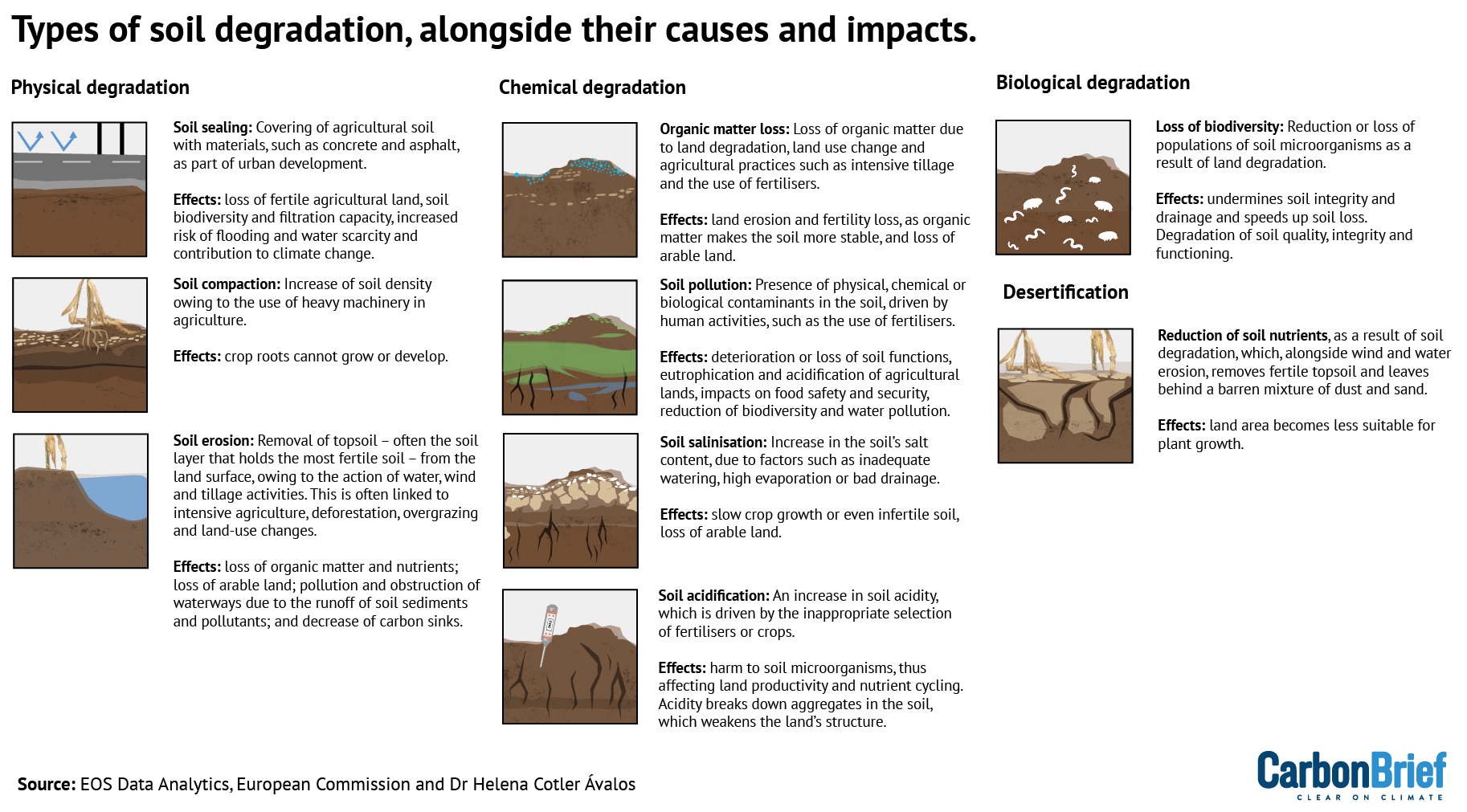
Types of soil degradation, alongside their causes and impacts. Source: EOS Data Analytics, European Commission and Dr Helena Cotler Ávalos. Credit: Kerry Cleaver for Carbon Brief.
Industrial agriculture is responsible for 22% of global greenhouse gas emissions and also contributes to water pollution and biodiversity loss.
The map below, from the FAO, shows the state of land degradation around the world, from “strong” (dark red) to “stable or improv[ing]” (bright green).
It shows that the most degraded agricultural lands are in the southern US, eastern Brazil and Argentina, the Middle East, northern India and China.
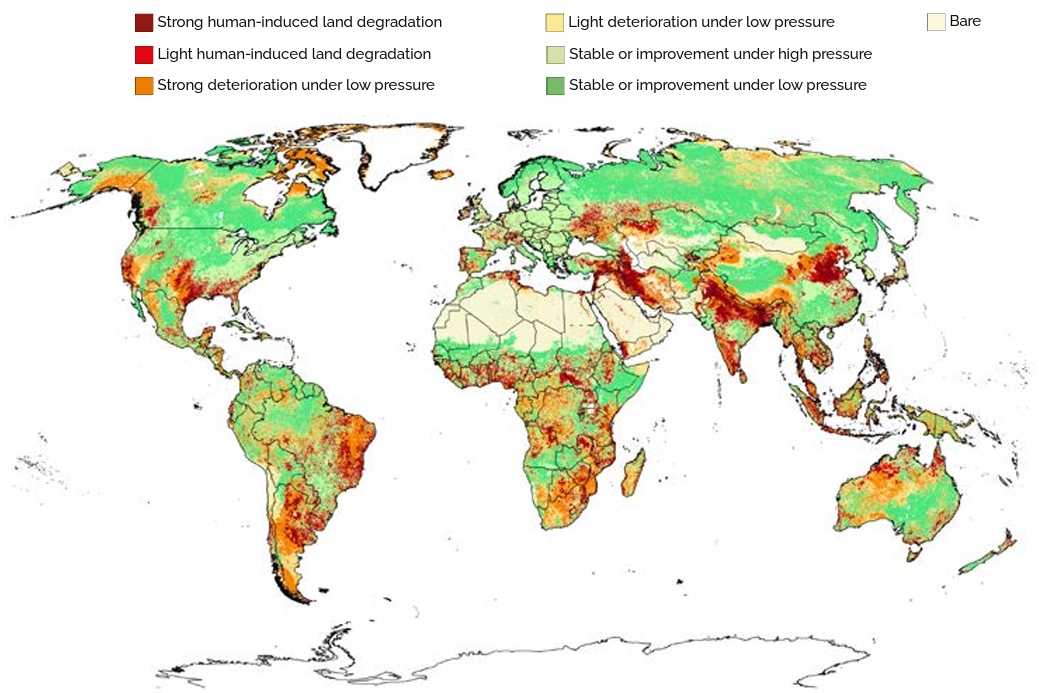
Soil degradation became widespread following the Green Revolution in the 1940s, says Cotler Ávalos. During the Green Revolution, many countries replaced their traditional, diversified farming systems with monocultures. The Green Revolution also promoted the use of synthetic fertilisers and pesticides.
These changes led to a “dramatic increase” in yields, but also resulted in disrupting the interactions between microorganisms in the soil.
Cotler Ávalos tells Carbon Brief:
“It is the microorganisms that give life to soils. They require organic matter, which has been replaced by [synthetic] fertilisers.”
Today, there is a widespread lack of data on the condition of soils in developing countries.
For example, in sub-Saharan Africa, there are few studies measuring the rate and extent of soil degradation due to insufficient, reliable data. In Latin America, data on soil carbon dynamics are scarce.
Conversely, the EU released a report in 2024 about the state of its soils, spanning various indicators of degradation, including pollution, compaction and biodiversity change. The report estimates that 61% of agricultural soils in the EU are “degraded”, as measured by changes in organic carbon content, soil biodiversity and erosion levels.
The UK also has its own agricultural land classification maps, which classifies the condition of agricultural soils into categories ranging from “excellent” to “very poor”. This year, a report found that 40% of UK agricultural soils are degraded due to intensive agriculture.
Cotler Ávalos tells Carbon Brief:
“No country in the global south has data on how much of its soil is contaminated by agrochemicals, how much is compacted by the use of intensive machinery, how much has lost fertility due to the failure to incorporate organic matter.
“What is not studied, what is not known, seems to be unimportant. The problem of soil erosion is a social and political problem, not a technical one.”
Improved soil data, indicators and maps can help guide the sustainable management and regeneration of agricultural soils, experts tell Carbon Brief.
Why is soil health important for food security and climate mitigation?
As around 95% of the food the world consumes is produced, directly or indirectly, on soil, its health is crucial to global food security.
Food production needs to satisfy the demand of the global population, which is currently 8.2 billion and is expected to surpass 9 billion by 2037.
A 2023 review study pointed out that the total area of global arable land is estimated at 30m square kilometres, or 24% of the total land surface. Approximately half of that area is currently cultivated.
Studies have estimated that soil degradation has reduced food production by between 13% and 23%.
The 2023 review study also projected that land degradation could cut global food production by 12% in the next 25 years, increasing food prices by 30%.
Another recent study found that, between 2000 and 2016, healthy soils were associated with higher yields of rainfed corn in the US, even under drought conditions.
Research shows that soil health plays an important role in nutrition.
For example, a 2022 study found that a deficiency in plant nutrients in rice paddy soils in India is correlated with malnutrition. The country faces a growing amount of degraded land – currently spanning 29% of the total geographical area – and more than 15% of children are reported to suffer from deficiencies in vitamins A, B12 and D, along with folate and zinc, according to the study.
Soil health is also crucial for mitigating climate change.
Global agricultural lands store around 47bn tonnes of carbon, with trees contributing 75% of this total, according to a 2022 study.
Agricultural soils could sequester up to 4% of global greenhouse gas emissions annually and make a “significant contribution to reaching the Paris Agreement’s emissions reduction objectives”, according to a report from the Organisation for Economic Co-operation and Development (OECD).
Some farming practices can reduce greenhouse gas emissions and improve soil carbon sequestration, such as improving cropland and grazing land management, restoring degraded lands and cultivating perennial crops or “cover crops” that help reduce erosion.
However, some scientists have warned that the amount of carbon that can be captured in global soils – and how long that carbon remains locked away – has been overestimated.
For example, an article published in Science in 2023 argued that one of the widely used models for simulating the flow of carbon and nitrogen in soils, known as DayCent, has “plenty of shortcomings”. It says:
“It doesn’t explicitly represent how soils actually work, with billions of microbes feasting on plant carbon and respiring much of it back to the atmosphere – while converting some of it to mineralised forms that can stick around for centuries.
“Instead, the model estimates soil carbon gains and losses based on parameters tuned using published experimental results.”
That, along with uncertainties associated with small-scale estimations, makes the model unable to accurately predict increases or decreases of soil carbon over time and, thus, a positive or negative impact on the climate, the outlet said.
How can CO2 removal techniques improve soil carbon?
Soils can also play a role in mitigating climate change through the use of CO2 removal techniques, such as biochar and enhanced rock weathering.
Biochar is a carbon-rich material derived from the burning of organic matter, such as wood or crop residues, in an oxygen-free environment – a process known as pyrolysis.
Biochar can be added to soils to enhance soil health and agricultural productivity.
Due to its porous nature, biochar holds nutrients in the soil, improving soil fertility, water retention, microbial activity and soil structure.
The long-term application of biochar can bring a range of benefits, such as improving yields, reducing methane emissions and increasing soil organic carbon, according to recent research that analysed 438 studies from global croplands.
However, the study added that many factors – including soil properties, climate and management practices – influence the magnitude of these effects.

Dr Dinesh Panday, a soil scientist at the agricultural research not-for-profit Rodale Institute and an expert in biochar, tells Carbon Brief that biochar typically is applied when soils have low carbon or organic matter content.
He adds that this technique is currently being used mostly in growing high-value crops, such as tomatoes, lettuce and peppers. For staple crops, including rice, wheat and maize, the use of biochar is only at a research stage, he adds.
Enhanced rock weathering is a process where silicate rocks are crushed and added to soils. The rocks then react with CO2 in the atmosphere and produce carbonate minerals, storing carbon from the atmosphere in the soil.
In the US, enhanced weathering could potentially sequester between 0.16-0.30bn tonnes of CO2 per year by 2050, according to a 2025 study.
Panday says that both biochar and enhanced weathering are mostly practised in developed countries at the moment and both have their own benefits and impacts. One of the disadvantages of biochar, he says, is its high cost, as producing it requires dedicated pyrolysis devices and the use of fossil gas. One negative effect of enhanced rock weathering is that it may alter nutrient cycling processes in the soil.
A 2023 comment piece by researchers from the University of Science and Technology of China raised some criticisms of biochar application, including the resulting emissions of methane and nitrous oxide, the enrichment of organic contaminants and heavy metals, and the dispersion of small particulate matter that can be harmful to human health.
Scientists still question how much carbon-removal techniques, such as enhanced rock weathering, can store in agricultural soils and for how long.
How can agricultural soil be regenerated?
Many types of farming practices can help conserve soil health and fertility.
These practices include minimising external inputs, such as fertilisers and pesticides, reducing tillage, rotating crops, using mixed cropping-livestock farming systems, applying manure or compost and planting perennial crops.
Low- or no-till practices involve stopping the large-scale turning over of soils. Instead, farmers using these systems plant seeds through direct drilling techniques, which helps maintain soil biodiversity. A 2021 review study found that in the south-eastern US, reducing tillage enhanced soil health by improving soil organic carbon, nitrogen and inorganic nutrients.
Mixed farming systems, which integrate the cultivation of crops with livestock, have also been found to be beneficial to soil health.
A 2022 study compared a conventional maize-soya bean rotation and a diverse four-year cropping system of maize, soya bean, oat and alfalfa in the mid-western US. It found that, compared to the conventional farm, the diversified system had a 62% increase in soil microbial biomass and a 157% increase in soil carbon.
One of the aims of soil regeneration is to make agricultural soil as much like a natural soil as possible, says Dr Jim Harris, professor of environmental technology at the Cranfield Environment Centre in the UK.
Harris, who is an expert in soil and ecological restoration, says that regenerating soils involves restoring the ecological processes that were once replaced by chemical inputs, while maintaining the soil’s ability to grow crops.
For example, he says, using regenerative agricultural approaches, such as rotational grazing, can help increase soil organic matter and fungi populations.
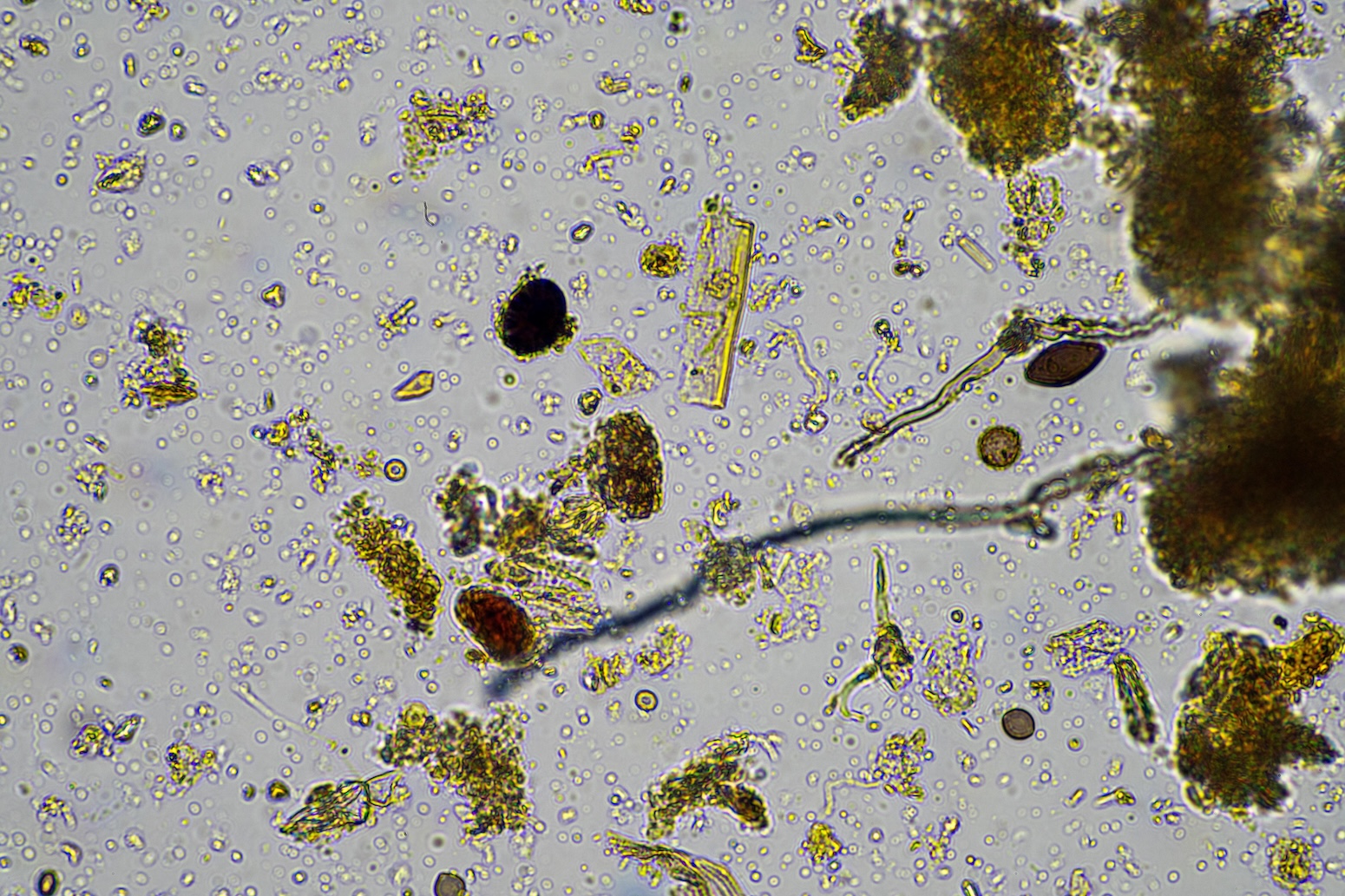
Which soil regeneration actions will be most successful will depend on the soil type, the natural climatic zone in which a farm is located, the rainfall and temperature regimes and which crops are being cultivated, he adds.
To measure the results of soil regeneration, farmers need to establish a baseline by determining the initial condition of the soil, then assess indicators of soil health. These indicators range from physical indicators, such as root depth, to biological indicators, such as earthworm abundance and microbial biomass.
In Sweden, researchers analysed these indicators in 11 farms that applied regenerative practices either recently or over the past 30 years. They found that the farms with no tillage, integration of livestock and organic matter permanent cover had higher levels of vegetation density and root abundance. Such practices had positive impacts on soil health, according to the researchers.
Switching from conventional to regenerative agriculture may take a farmer five to 10 years, Harris says. This is because finding the variants of a crop that are most resistant to, say, drought and pests could take a “long time”, but, ultimately, farms will have “more stable yields”, he says.
Harris tells Carbon Brief:
“Where governments can really help [is] in providing farmers with funds that allow them to make that transition over a longer period of time.”
Research has found that transitioning towards regenerative agriculture has economic benefits for farmers.
For example, farmers in the northern US who used regenerative agriculture for maize cropping had “29% lower grain production, but 78% higher profits over traditional corn production systems”, according to a 2018 study. (The profit from regenerative farms is due to low seed and fertiliser consumption and higher income generated by grains and other products produced in regenerative corn fields, compared to farms that only grow corn conventionally.)
A 2022 review study found that regenerative farming practices applied in 10 temperate countries over a 15-year period increased soil organic carbon without reducing yields during that time.
Meanwhile, a 2024 study analysing 20 crop systems in North America found that maize and soya bean yields increased as the crop system diversified and rotated. For example, maize income rose by $200 per hectare in sites where rotation included annual crops, such as wheat and barley. Under the same conditions, soya bean income increased by $128 per hectare, the study found.
The study pointed out that crop rotation – one of the characteristics of regenerative agriculture – contributes to higher yields, thanks to the variety of crops with different traits that allow them to cope with different stressors, such as drought or pests.
However, other research has questioned whether regenerative soil practices can have benefits for both climate mitigation and crop production.
A 2025 study modelled greenhouse gas emissions and yields in crops through to the end of the century. It found that grass cover crops with no tillage reduced 32.6bn tonnes of CO2-equivalent emissions by 2050, but reduced crop yields by 4.8bn tonnes. The lowest production losses were associated with “modest” mitigation benefits, with just 4.4bn tonnes of CO2e emissions reduced, the study added.
The authors explained that the mitigation potential of cover crops and no tillage was lower than previous studies that overlooked certain factors, such as soil nitrous oxide, future climate change and yields. Moreover, they warned, carbon removal using regenerative farming methods risks the release of emissions back into the atmosphere, if soil management returns to unsustainable practices.
Several of the world’s largest agricultural companies, including General Mills, Cargill, Unilever, Mars and Mondelez, have committed to regenerative agriculture goals. Nestlé, for example, has said that it is implementing regenerative agriculture practices in its supply chain that have had “promising initial results”. It adds that “farmers, in many cases, stand to see an increase in crop yields and profits”. As a result, the firm says it is committed to sourcing 50% of its ingredients from farms implementing regenerative agriculture by 2030.
However, Trellis, a sustainability-focused organisation, cautioned that “these results should be taken somewhat sceptical[ly]”, as there is no set definition on what regenerative agriculture is and measurement of the results is “lacking”.
In some places, the regeneration or recovery of agricultural soils is still practised alongside farmers’ traditional knowledge.
Ricardo Romero is an agronomist and the managing director of the cooperative Las Cañadas – Cloud Forest, lying 1300m above sea level in Mexico’s Veracruz mountains. There, cloud forests sit between tropical rainforest and pine forests, in what Romero considers “a very small ecosystem globally”, optimal for coffee plantations.
His cooperative is located on land previously used for industrial cattle farming. Today, the land is used for agroecological production of coffee, agroforestry and reforestation. The workers in the cooperative are mostly peasants who take on production and use techniques to improve soil fertility that they have learned by doing.

Romero says the soils in his cooperative have improved and crop yields have been maintained thanks to the compost they produce. He tells Carbon Brief:
“We are still in the learning stage. We sort of aspire to achieve what cultures such as the Chinese, Koreans and Japanese did. They returned all their waste to the fields and their agriculture lasted 4,000 years without chemical or organic fertilisers”.
What international policies promote soil health?
Soil health and soil regeneration feature in four of the targets under the UN Sustainable Development Goals (SDGs).
(There are 169 targets under the SDGs that contain measurable indicators for assessing progress towards each of the 17 goals.)
For example, target 15.3 calls on countries to “restore degraded land and soil” and “strive to achieve a land-degradation neutral world”.
Soil health is increasingly being recognised in international negotiations under the UN Framework Convention on Climate Change (UNFCCC), UN Convention on Biological Diversity (UN CBD) and the UN Convention to Combat Desertification (UNCCD), says Katie McCoshan, senior partnerships and international engagement manager for the Food and Land Use Coalition (FOLU).
Each of these conventions has established its own work groups, declarations and frameworks around soil health in recent years.
Ideally, says McCoshan, action on soils should be integrated across the three different conventions, as well as in conversations around food and nutrition.
However, work across the three conventions remains siloed.
Currently, agriculture is formally addressed under the UNFCCC via the Sharm el-Sheikh joint work on implementation of climate action on agriculture and food security, a four-year work plan agreed at COP27 in 2022. This work group is meant to provide countries with technical support and facilitate collaboration and research.
The COP27 decision that created the Sharm el-Sheikh agriculture programme “recognised that soil and nutrient management practices and the optimal use of nutrients…lie at the core of climate-resilient, sustainable food production systems and can contribute to global food security”.
At COP28 in Dubai, the presidency announced the Emirates Declaration on Sustainable Agriculture, Resilient Food Systems and Climate Action. The 160 countries that signed the declaration committed to integrating agriculture and food systems into their nationally determined contributions, national adaptation plans and national biodiversity strategies and action plans (NBSAPs). The declaration also aims to enhance soil health, conserve and restore land.
Harris says the Emirates Declaration is a “great first step”, but adds that it will “take time to develop the precise on-the-ground mechanisms” to implement such policies in all countries, as “they are moving at different speeds”.
Within the UNFCCC process, soil has also featured in non-binding initiatives such as the 4 per 1000, adopted at COP21 in Paris. The initiative aims to increase the amount of carbon sequestered in the top 30-40cm of global agricultural soils by 0.4%, or four parts per thousand, per year.
The UNCCD COP16, which took place in 2024 in Saudi Arabia, delivered a decision to “encourage” countries to avoid, reduce and reverse soil degradation of agricultural lands and improve soil health.
Although COP16 did not deliver a legally binding framework to combat drought, it resulted in the creation of the Riyadh Global Drought Resilience Partnership, a global initiative integrated by countries, international organisations and other countries to allocate $12bn towards initiatives to restore degraded land and enhance resilience against drought.
The COP also resulted in the Riyadh Action Agenda, which aspires to conserve and restore 1.5bn hectares of degraded land globally by 2030.
Although soil health appears under both conventions, it is not included as formally in the UNFCCC as in the UNCCD – as in the latter there is a direct mandate for countries to address soil health and land restoration, McCoshan tells Carbon Brief.
Under the UNCCD, countries have to establish land degradation neutrality (LDN) targets by 2030. To date, more than 100 countries have set these targets.
Under the biodiversity convention, COP15 held in Montreal in 2022 delivered the Kunming-Montreal Global Biodiversity Framework (GBF), a set of goals and targets aiming to “halt and reverse” biodiversity loss by 2030. Under the framework, targets 10 and 11 reference sustainable management of agriculture through agroecological practices, and the conservation and restoration of soil health, respectively.
A recent study suggests that restoring 50% of global degraded croplands could avoid the emission of more than 20bn tonnes of CO2 equivalent by 2050, which would be comparable to five times the annual emissions from the land-use sector. It would also bring biodiversity benefits and contribute to target 10 of the GBF and to UNCCD COP16 recommendations, the study added.
McCoshan tells Carbon Brief:
“[All] the pledges are important and they hold countries accountable, but that alone isn’t what we need. We’ve got to get the financing right and co-create solutions with farmers, Indigenous people, youth, businesses and civil society as well.”
The post Q&A: The role of soil health in food security and tackling climate change appeared first on Carbon Brief.
Q&A: The role of soil health in food security and tackling climate change
Greenhouse Gases
DeBriefed 12 December: EU under ‘pressure’; ‘Unusual warmth’ explained; Rise of climate boardgames
Welcome to Carbon Brief’s DeBriefed.
An essential guide to the week’s key developments relating to climate change.
This week
EU sets 2040 goal
CUT CRUNCHED: The EU agreed on a legally binding target to reduce greenhouse gas emissions by 90% from 1990 levels by 2040, reported the EU Observer. The publication said that this agreement is “weaker” than the European Commission’s original proposal as it allows for up to five percentage points of a country’s cuts to be achieved by the use of foreign carbon credits. Even in its weakened form, the goal is “more ambitious than most other major economies’ pledges”, according to Reuters.
PETROL CAR U-TURN: Commission president Ursula von der Leyen has agreed to “roll back an imminent ban on the sale of new internal combustion-engined cars and vans after late-night negotiations with the leader of the conservative European People’s Party,” reported Euractiv. Car makers will be able to continue selling models with internal combustion engines as long as they reduce emissions on average by 90% by 2035, down from a previously mandated 100% cut. Bloomberg reported that the EU is “weighing a five-year reprieve” to “allow an extension of the use of the combustion engine until 2040 in plug-in hybrids and electric vehicles that include a fuel-powered range extender”.
CORPORATE PRESSURE: Reuters reported that EU countries and the European parliament struck a deal to “cut corporate sustainability laws, after months of pressure from companies and governments”. It noted that the changes exempt businesses with fewer than 1,000 employees from reporting their environmental and social impact under the corporate sustainability reporting directive. The Guardian wrote that the commission is also considering a rollback of environment rules that could see datacentres, artificial intelligence (AI) gigafactories and affordable housing become exempt from mandatory environmental impact assessments.
Around the world
- EXXON BACKPEDALS: The Financial Times reported on ExxonMobil’s plans to “slash low-carbon spending by a third”, amounting to a reduction of $10bn over the next 5 years.
- VERY HOT: 2025 is “virtually certain” to be the second or third-hottest year on record, according to data from the EU’s Copernicus Climate Change Service, covered by the Guardian. It reported that global temperatures from January-November were, on average, 1.48C hotter than preindustrial levels.
- WEBSITE WIPE: Grist reported that the US Environmental Protection Agency has erased references to the human causes of climate change from its website, focusing instead on “natural processes”, such as variations in the Earth’s orbit. On BlueSky, Carbon Brief contributing editor Dr Zack Labe described the removal as “absolutely awful”.
- UN REPORT: The latest global environment outlook, a largest-of-its-kind UN environment report, “calls for a new approach to jointly tackle the most pressing environmental issues including climate change and biodiversity loss”, according to the Associated Press. However, report co-chair Sir Robert Watson told BBC News that a “small number of countries…hijacked the process”, diluting its potential impact.
$80bn
The amount that Chinese firms have committed to clean technology investments overseas in the past year, according to Reuters.
Latest climate research
- Increases in heavy rainfall and flooding driven by fossil-fuelled climate change worsened recent floods in Asia | World Weather Attribution
- Human-caused climate change played a “substantial role” in driving wildfires and subsequent smoke concentrations in the western US between 1992-2020 | Proceedings of the National Academy of Sciences
- Thousands of land vertebrate species over the coming decades will face extreme heat and “unsuitable habitats” throughout “most, or even all” of their current ranges | Global Change Biology
(For more, see Carbon Brief’s in-depth daily summaries of the top climate news stories on Monday, Tuesday, Wednesday, Thursday and Friday.)
Captured
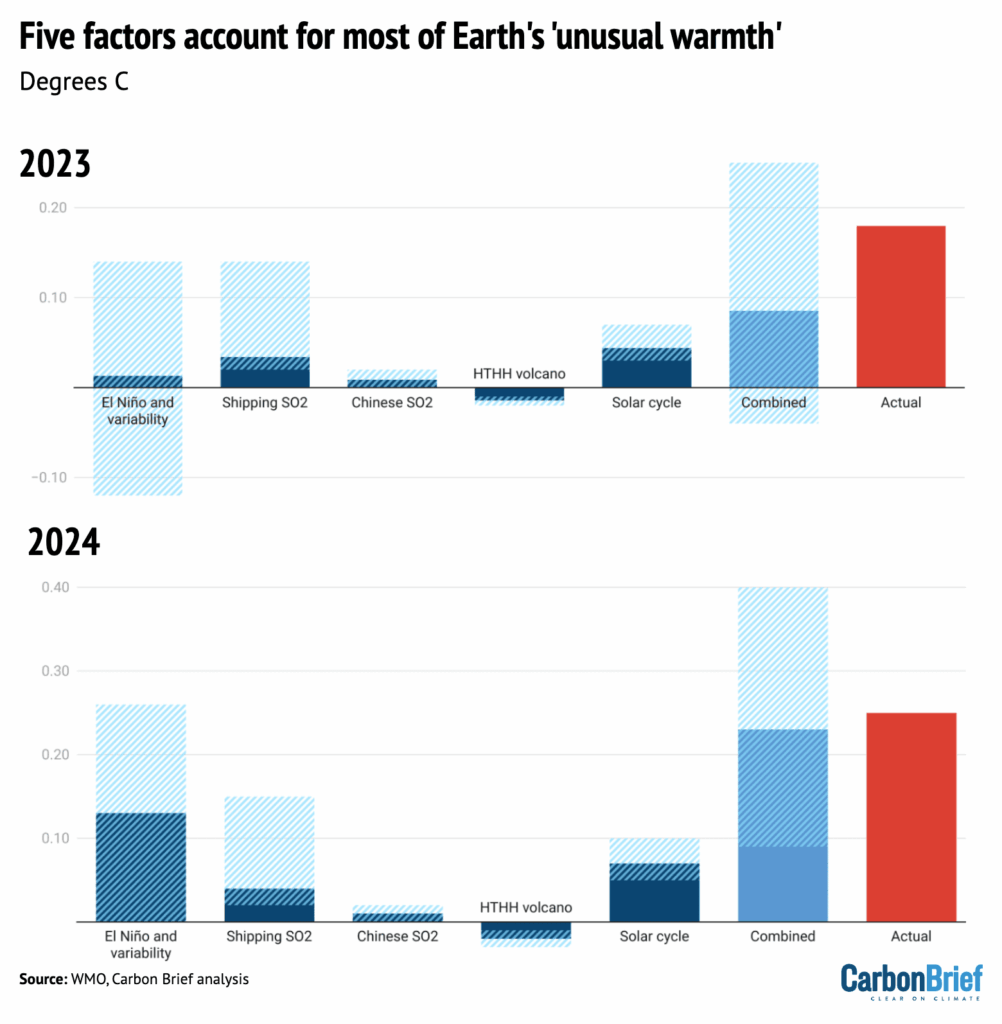
The years 2023 and 2024 were the warmest on record – and 2025 looks set to join them in the top three. The causes of this apparent acceleration in global warming have been subject to a lot of attention in both the media and the scientific community. The charts above, drawn from a new Carbon Brief analysis, show how the natural weather phenomenon El Niño, sulphur dioxide (SO2) emissions from shipping, Chinese SO2, an eruption from the Hunga Tonga-Hunga Ha’apai volcano and solar cycle changes account for most of the “unusual warmth” of recent years. Dark blue bars represent the contribution of individual factors and their uncertainties (hatched areas), the light blue bar shows the combined effects and combination of uncertainties and the red bar shows the actual warming, compared with expectations.
Spotlight
Climate change boardgames
This week, Carbon Brief reports on the rise of climate boardgames.
Boardgames have always made political arguments. Perhaps the most notorious example is the Landlord’s Game published by US game designer and writer Lizzie Magie in 1906, which was designed to persuade people of the need for a land tax.
This game was later “adapted” by US salesman Charles Darrow into the game Monopoly, which articulates a very different set of values.
In this century, game designers have turned to the challenge of climate change.
Best-selling boardgame franchise Catan has spawned a New Energies edition, where players may choose to “invest in clean energy resources or opt for cheaper fossil fuels, potentially causing disastrous effects for the island”.
But perhaps the most notable recent release is 2024’s Daybreak, which won the prestigious Kennerspiel des Jahre award (the boardgaming world’s equivalent of the Oscars).
Rolling the dice
Designed by gamemakers Matteo Menapace and Matt Leacock, Daybreak sees four players take on the role of global powers: China, the US, Europe and “the majority world”, each with their own strengths and weaknesses.
Through playing cards representing policy decisions and technologies, players attempt to reach “drawdown”, a state where they are collectively producing less CO2 than they are removing from the atmosphere.
“Games are good at modelling systems and the climate crisis is a systemic crisis,” Daybreak co-designer Menapace told Carbon Brief.
In his view, boardgames can be a powerful tool for getting people to think about climate change. He said:
“In a video game, the rules are often hidden or opaque and strictly enforced by the machine’s code. In contrast, a boardgame requires players to collectively learn, understand and constantly negotiate the rules. The players are the ‘game engine’. While videogames tend to operate on a subconscious level through immersion, boardgames maintain a conscious distance between players and the material objects they manipulate.
“Whereas videogames often involve atomised or heavily mediated social interactions, boardgames are inherently social experiences. This suggests that playing boardgames may be more conducive to the exploration of conscious, collective, systemic action in response to the climate crisis.”
Daybreak to Dawn
Menapace added that he is currently developing “Dawn”, a successor to Daybreak, building on lessons he learned from developing the first game, telling Carbon Brief:
“I want the next game to be more accessible, especially for schools. We learned that there’s a lot of interest in using Daybreak in an educational context, but it’s often difficult to bring it to a classroom because it takes quite some time to set up and to learn and to play.
“Something that can be set up quickly and that can be played in half the time, 30 to 45 minutes rather than an hour [to] an hour and a half, is what I’m currently aiming for.”
Dawn might also introduce a new twist that explores whether countries are truly willing to cooperate on solving climate change – and whether “rogue” actors are capable of derailing progress, he continued:
“Daybreak makes this big assumption that the world powers are cooperating, or at least they’re not competing, when it comes to climate action. [And] that there are no other forces that get in the way. So, with Dawn, I’m trying to explore that a bit more.
“Once the core game is working, I’d like to build on top of that some tensions, maybe not perfect cooperation, [with] some rogue players.”
Watch, read, listen
WELL WATCHERS: Mother Jones reported on TikTok creators helping to hold oil companies to account for cleaning up abandoned oil wells in Texas.
RUNNING SHORT: Wired chronicled the failure of carbon removal startup Running Tide, which was backed by Microsoft and other tech giants.
PARIS IS 10: To mark the 10th anniversary of the Paris Agreement, climate scientist Prof Piers Forster explained in Climate Home News “why it worked” and “what it needs to do to survive”.
Coming up
- 15-19 December: American Geophysical Union (AGU) annual meeting, New Orleans
- 15-19 December: 70th Meeting of the Global Environment Facility (Gef) Council, online
- 16 December: International Energy Agency: Future of electricity in the Middle East and North Africa webinar, online
Pick of the jobs
- Natural Resources Wales, senior strategic environmental policy specialist | Salary: Unknown. Location: Wales (hybrid)
- The Nature Conservancy, director of conservation – Mata Atlântica | Salary: Unknown. Location: São Paulo, Belo Horizonte, Rio de Janeiro and nearby cities, Brazil
- Barcelona Supercomputing Centre, postdoctoral researcher – downscaling for climate services | Salary: Unknown. Location: Barcelona, Spain
DeBriefed is edited by Daisy Dunne. Please send any tips or feedback to debriefed@carbonbrief.org.
This is an online version of Carbon Brief’s weekly DeBriefed email newsletter. Subscribe for free here.
The post DeBriefed 12 December: EU under ‘pressure’; ‘Unusual warmth’ explained; Rise of climate boardgames appeared first on Carbon Brief.
DeBriefed 12 December: EU under ‘pressure’; ‘Unusual warmth’ explained; Rise of climate boardgames
Greenhouse Gases
‘Cali Fund’ aiming to raise billions for nature receives first donation – of just $1,000
A major biodiversity fund – which could, in theory, generate billions of dollars annually for conservation – received its first donation of just $1,000 in November.
The Cali Fund was created under the UN Convention on Biological Diversity (CBD) at the COP16 nature negotiations in Cali, Colombia, last year.
On 19 November, nine months after the fund officially launched, UK start-up TierraViva AI put forward the first contribution.
The $1,000 payment is an “ice-breaker”, the company’s chief executive tells Carbon Brief, aimed at encouraging others “who may be hesitating” to pay in.
The fund is designed to be a way for companies that rely on nature’s genetic resources to share some of their earnings with the developing, biodiverse countries where many of the original resources are found.
Companies use genetic data from these materials to develop products, such as vaccines and skin cream.
One expert describes the $1,000 as a good “first step”, but says it is “time for larger actors to step forward”. Another says it “squarely points the finger to the profit-making enterprises that are not contributing”.
The CBD is “pleased” about the first payment, a spokesperson tells Carbon Brief, adding that “many discussions” are ongoing about future donations.
Funding biodiversity action
Companies all around the world use genetic materials from plants, animals, bacteria and fungi often found in biodiversity-rich, global south countries to develop their products.
There are existing rules in place to secure consent and ensure compensation if companies or researchers travel to a country to physically gather these materials.
Today, however, much of this information is available in online databases – with few rules in place around access. This genetic data is known as digital sequence information (DSI).
The Cali Fund is part of an effort to close this loophole.
The COP16 agreement on the creation of the fund outlined that large companies in several sectors, including pharmaceutical, cosmetic, biotechnology, agribusiness and technology, “should” contribute a cut of the money they earn from the use of these materials. (See: Carbon Brief’s infographic on DSI.)
The money is intended to fund biodiversity action, with 50% of resources going to Indigenous peoples and local communities who protect vast swathes of the world’s nature and biodiversity.
These contributions, however, are voluntary.
The fund officially launched at the resumed COP16 negotiations in Rome in February 2025, where a spokesperson for the CBD said that first contributions could be announced in spring.
However, Carbon Brief reported in August that the fund was still empty.
On 19 November, the first contribution was announced during the COP30 UN climate summit. At $1,000, the amount was significantly lower than the potential millions that larger companies could pay in.
A UK government press release described it as a “major milestone” that will “pav[e] the way for others to do the same and mobilise private sector finance for nature at scale”.
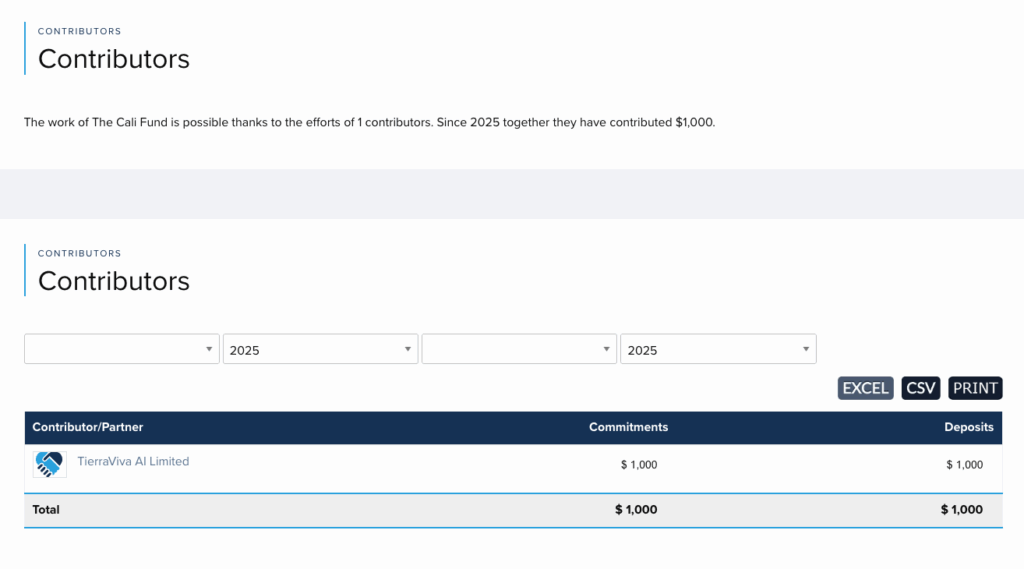
The payment was an “expression of our commitment to the objectives of the Cali Fund”, TierraViva AI chief executive Dr Paul Oldham wrote in a letter to the executive secretary of the CBD, Astrid Schomaker.
The $1,000 is an “initial contribution”, Oldham said, and the company plans to give more “as our business grows”. Based in the UK with a team of programmers in Nairobi, TierraViva AI was set up in 2023 and uses AI to support conservation.
An anthropologist who worked on Indigenous peoples’ rights in the Amazon, Oldham’s research helped inform the list of sectors most likely to “directly or indirectly benefit from the use of DSI”, including “generative biology” and AI companies.
Oldham noted in a speech at the sidelines of COP30 that although the company’s earnings are not large enough to meet the contribution thresholds set out in the Cali Fund agreement, its contribution showed that companies “of any size” can pay in.

He tells Carbon Brief that while “some” companies “are not serious about contributing and are seeking to delay” paying into the fund, others have different concerns, including the “need for a level playing field” and positive incentives to contribute:
“This will be hard-earned company money, so it’s reasonable enough to imagine that one of the first questions companies will want an answer to is: ‘well, what is this actually going to be spent on?’ And: ‘what is the benefit of this to us’, which is likely to vary by sector.
“In my view, the best way forward would be for companies that can to make contributions. That would give everybody, including governments, confidence that there might be constructive ways to address difficult topics.”
Future contributions
A spokesperson for the CBD tells Carbon Brief:
“We are pleased that the Cali Fund is not only ‘open for business’, but that this first contribution also demonstrates it is fully operational. We thank and congratulate TierraViva AI for being the first company to step up.”
“Many discussions” are ongoing around future donations to the fund, the spokesperson says, and the CBD is “hopeful that further announcements can be made soon”, ahead of the next UN biodiversity summit, COP17, in October 2026.
Asked whether the CBD was expecting more contributions at this stage, the spokesperson says the fund was set up in “very short order” and that the first payment shows that companies are “able to contribute”.
US biotechnology company Ginkgo Bioworks was the first to pledge to contribute to the fund earlier this year, but has so far not put forward any money. The company did not respond to Carbon Brief’s request for comment.
Carbon Brief reported earlier this year that at least two companies were contacted by a UK department with opportunities to be involved in the Cali Fund before its launch in February, but no company took up on the offer.

The first contribution coming from a “startup that has just begun operations squarely points the finger to the profit-making enterprises that are not contributing”, Dr Siva Thambisetty, associate professor of law at the London School of Economics, tells Carbon Brief. Thambisetty adds:
“Strident cries of lack of legal certainty, unfairness or stacking obligations [combining responsibilities from different agreements and laws] would be more credible if industry organisations encouraged large firms that use DSI to begin contributing, instead of denying the last 20 years of multilateral [negotiations] that have led to this point.”
Dr June Rubis – Indigenous peoples and local communities (IPLC) lead from Asia on the Cali Fund’s steering committee – welcomes TierraViva AI’s “first step”, but tells Carbon Brief that the “real test lies ahead” and that it is “now time for larger actors to step forward”.
She says the Cali Fund offers “clarity” on how the private sector can directly increase support to UN-backed funds at a time when “states are retreating” from their climate and biodiversity finance obligations:
“It’s not a voluntary offsetting scheme or a…risky or fringe fund; it’s a multilateral mechanism designed to meet the highest fiduciary and equity standards. We invite companies to see this not as philanthropy, but as participation in a globally endorsed system where trust is institutionalised, benefits are traceable and equity is operationalised.
“Contributing to the Cali Fund isn’t just ethical, it’s strategic. [But] It’s about more than funding: it’s about trust, power-sharing and making sure IPLCs are part of the decisions, not just the outcomes.”
The post ‘Cali Fund’ aiming to raise billions for nature receives first donation – of just $1,000 appeared first on Carbon Brief.
‘Cali Fund’ aiming to raise billions for nature receives first donation – of just $1,000
Greenhouse Gases
Net-zero scenario is ‘cheapest option’ for UK, says energy system operator
A scenario that meets the “net-zero by 2050” goal would be the “cheapest” option for the UK, according to modelling by the National Energy System Operator (NESO).
In a new report, the organisation that manages the UK’s energy infrastructure says its “holistic transition” scenario would have the lowest cost over the next 25 years, saving £36bn a year – some 1% of GDP – compared to an alternative scenario that slows climate action.
These savings are from lower fuel costs and reduced climate damages, relative to a scenario where the UK fails to meet its climate goals, known as “falling behind”.
The UK will need to make significant investments to reach net-zero, NESO says, but this would cut fossil-fuel imports, support jobs and boost health, as well as contributing to a safer climate.
Slowing down these efforts would reduce the scale of investments needed, but overall costs would be higher unless the damages from worsening climate change are “ignored”, the report says.
In an illusory world where climate damages do not exist, slowing the UK’s efforts to cut emissions would generate “savings” of £14bn per year on average – some 0.4% of GDP.
NESO says that much of this £14bn could be avoided by reaching net-zero more cheaply and that it includes costs unrelated to climate action, such as a faster rollout of data centres.
Notably, the report appears to include efforts to avoid the widespread misreporting of a previous edition, including in the election manifesto of the hard-right, climate-sceptic Reform UK party.
Overall, NESO warns that, as well as ignoring climate damages, the £14bn figure “does not represent the cost of achieving net-zero” and cannot be compared with comprehensive estimates of this, such as the 0.2% of GDP total from the UK’s Climate Change Committee (CCC).
Net-zero is the ‘cheapest option’
Every year, NESO publishes its “future energy scenarios”, a set of four pathways designed to explore how the nation’s energy system might change over the coming decades.
(Technically the scenarios apply to the island of Great Britain, rather than the whole UK, as Northern Ireland’s electricity system is part of a separate network covering the island of Ireland.)
Published in July, the scenarios test a series of questions, such as what it would mean for the UK to meet its climate goals, whether it is possible to do so while relying heavily on hydrogen and what would happen if the nation was to slow down its efforts to cut emissions.
The scenarios have a broad focus and do not only consider the UK’s climate goals. In addition, they also explore the implications of a rapid growth in electricity demand from data centres, the potential for autonomous driving and many other issues.
With so many questions to explore, the scenarios are not designed to keep costs to a minimum. In fact, NESO does not publish related cost estimates in most years.
This year, however, NESO has published an “economics annex” to the future energy scenarios. It last published a similar exercise in 2020, with the results being widely misreported.
In the new annex, NESO says that the UK currently spends around 10% of GDP on its energy system. This includes investments in new infrastructure and equipment – such as cars, boilers or power plants – as well as fuel, running and maintenance costs.
This figure is expected to decline to around 5% of GDP by 2050 under all four scenarios, NESO says, whether they meet the UK’s net-zero target or not.
For each scenario, the annex adds up the total of all investments and ongoing costs in every year out to 2050. It then adds an estimate of the economic damages from the greenhouse gas emissions that primarily come from burning fossil fuels, using the Treasury’s “green book”.
When all of these costs are taken into account, NESO says that the “cheapest” option is a pathway that meets the UK’s climate goals, including all of the targets on the way to net-zero by 2050.
It says this pathway, known as “holistic transition”, would bring average savings of £36bn per year out to 2050, relative to a pathway where the UK slows its efforts on climate change.
The overall savings, illustrated by the dashed line in the figure below, stem primarily from lower fuel costs (orange bars) and reduced climate damages (white bars).
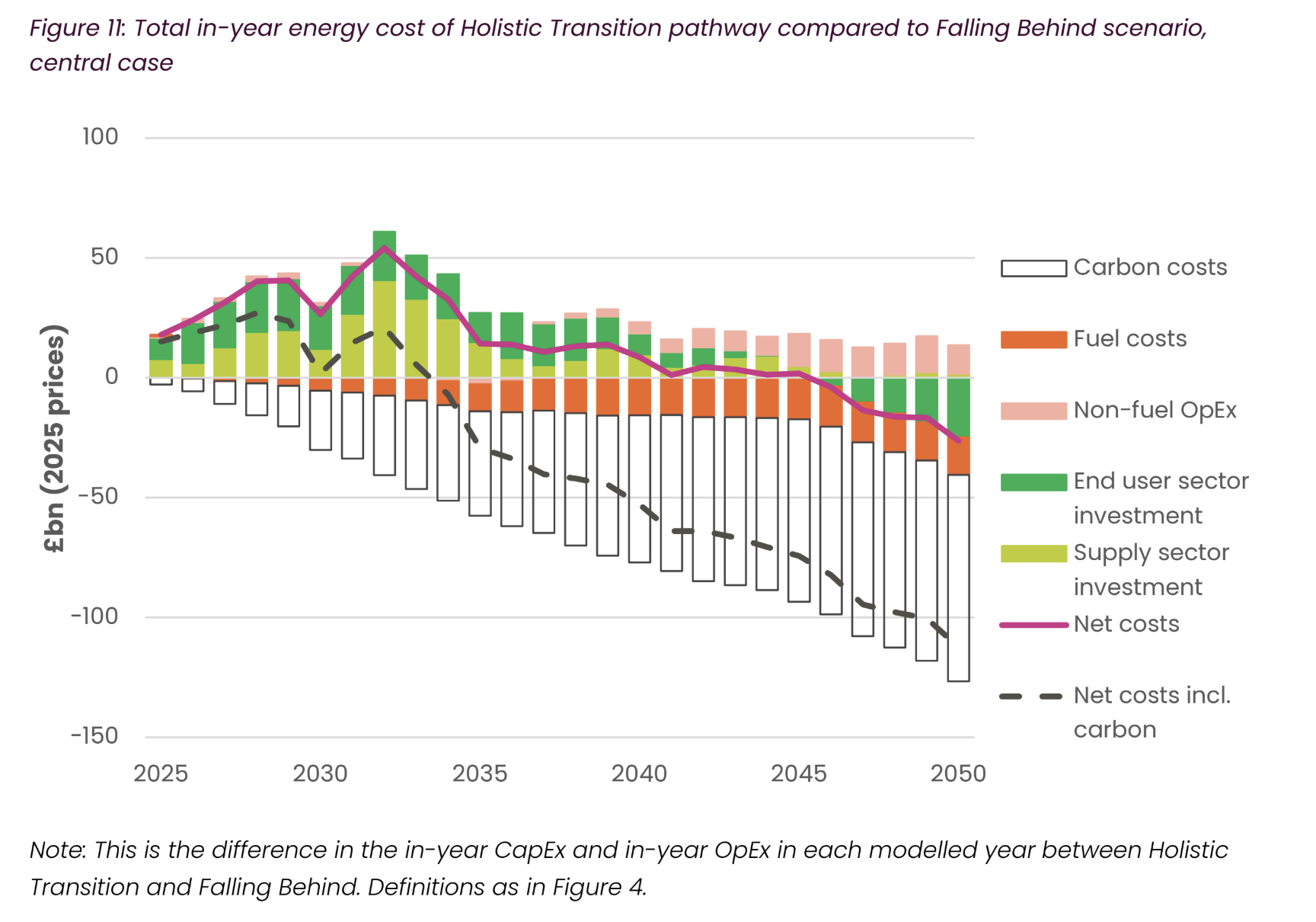
Note that the carbon pricing that is already applied to power plants and other heavy industry under the UK’s emissions trading system (ETS) is excluded from running costs in the annex, appearing instead within the wider “carbon costs” category.
This makes the running costs of fossil-fuel energy sources seem cheaper than they really are, when including the ETS price.
Net-zero requires significant investment
While NESO says that its net-zero compliant “holistic transition” pathway is the cheapest option for the UK, it does require significant upfront investments.
The scale of the additional investments needed to stay on track for the UK’s climate goals, beyond a pathway where those targets are not met, is illustrated in the figure below.
This shows that the largest extra investments would need to be made in the power sector, such as by building new windfarms (shown by the dark yellow bars). This is followed by investment needs for homes, such as to install electric heat pumps instead of gas boilers (dark red bars).
These additional investments would amount to around £30bn per year out to 2050, but with a peak of as much as £60bn over the next decade.
These investments would be offset by lower fuel bills, including reduced gas use in homes (pale red) and lower oil use in transport (mid green).
Notably, NESO says it expects EVs to be cheaper to buy than petrol cars from 2027, meaning there are also significant savings in transport capital expenditure (“CapEx”, dark green).

Again, the biggest savings in “holistic transition” relative to “falling behind” would come from avoided climate damages – described by NESO as “carbon costs”.
Net-zero cuts fossil-fuel imports
In addition to avoided climate damages, NESO says that reaching the UK’s net-zero target would bring wider benefits to the economy, including lower fuel imports.
Specifically, it says that climate efforts would “materially reduce” the UK’s dependency on overseas gas, with imports falling to 78% below current levels by 2050 in “holistic transition”. Under the “falling behind” scenario, imports rise by 35%”, despite higher domestic production.
This finding, shown in the figure below, is the opposite of what has been argued by many of those that oppose the UK’s net-zero target.

NESO goes on to argue that the shift to net-zero would have wider economic benefits. These include a shift from buying imported fossil fuels to investing money domestically instead, which “could bring local economic benefits and support future employment”.
The operator says that there is the “potential for more jobs to be created than lost in the transition to net-zero” and that there would be risks to UK trade if it fails to cut emissions, given exports to the EU – the UK’s main trading partner – would be subject to the bloc’s new carbon border tax.
Beyond the economy, NESO points to studies finding that the transition to net-zero would have other benefits, including for human health and the environment.
It does not attempt to quantify these benefits, but points to analysis from the CCC finding that health benefits alone could be worth £2.4-8.2bn per year by 2050.
Investment is higher for net-zero than for ‘not-zero’
It is clear from the NESO annex that its net-zero compliant “holistic transition” pathway would entail significantly more upfront investment than if climate action is slowed under “falling behind”.
This idea, in effect, is the launchpad for politicians arguing that the UK should walk away from its climate commitments and stop building new low-carbon infrastructure.
As already noted, the NESO analysis shows that this would increase costs to the UK overall.
Still, NESO’s new report adds that “falling behind” would “save” £14bn a year – relative to meeting the UK’s net-zero target – as long as carbon costs are “ignored”.
Specifically, it says that ignoring carbon costs, “holistic transition” would cost an average of £14bn a year more out to 2050 than “falling behind”, which misses the net-zero target. This is equivalent to 0.4% of the UK’s GDP and is illustrated by the solid pink line in the figure below.

Some politicians are indeed now willing to ignore the problem of climate change and the damages caused by ongoing greenhouse gas emissions. These politicians may therefore be tempted to argue that the UK could “save” £14bn a year by scrapping net-zero.
However, NESO’s report cautions against this, stating explicitly that the “costs discussed here do not represent the cost of achieving net-zero emissions”. It says:
“Our pathways cannot provide firm conclusions over the relative costs attached to the choices between pathways…We reiterate that the costs discussed here do not represent the cost of achieving net-zero emissions.”
It says that the scenarios have not been designed to minimise costs and that it would be possible to reach net-zero more cheaply, for example by focusing more heavily on EVs and renewables instead of hydrogen and nuclear.
Moreover, it says that some of the difference in costs between “holistic transitions” and “falling behind” is unrelated to climate action. Specifically, it says that electricity demand from data centres is around twice as high in “holistic transitions”, adding some £5bn a year in costs in 2050.
In addition, NESO says that most of the “saving” in “falling behind” would be wiped out if fossil fuel prices are higher than expected – falling from £14bn per year to just £5bn a year – even before considering climate damages and wider benefits, such as for health.
Finally, NESO says that failing to make the transition to net-zero would leave the UK more exposed to fossil-fuel price shocks, such as the global energy crisis that added 1.8% to the nation’s energy costs in 2022. It says a similar shock would only cost 0.3% of GDP in 2050 if the country has reached net-zero – as in “holistic transition” – whereas costs would remain high in “falling behind”.
The post Net-zero scenario is ‘cheapest option’ for UK, says energy system operator appeared first on Carbon Brief.
Net-zero scenario is ‘cheapest option’ for UK, says energy system operator
-
Climate Change4 months ago
Guest post: Why China is still building new coal – and when it might stop
-
Greenhouse Gases4 months ago
Guest post: Why China is still building new coal – and when it might stop
-
Climate Change2 years ago
Spanish-language misinformation on renewable energy spreads online, report shows
-

 Greenhouse Gases2 years ago
Greenhouse Gases2 years ago嘉宾来稿:满足中国增长的用电需求 光伏加储能“比新建煤电更实惠”
-
Climate Change Videos2 years ago
The toxic gas flares fuelling Nigeria’s climate change – BBC News
-

 Climate Change2 years ago
Climate Change2 years ago嘉宾来稿:满足中国增长的用电需求 光伏加储能“比新建煤电更实惠”
-

 Carbon Footprint2 years ago
Carbon Footprint2 years agoUS SEC’s Climate Disclosure Rules Spur Renewed Interest in Carbon Credits
-
Climate Change2 years ago
Why airlines are perfect targets for anti-greenwashing legal action




